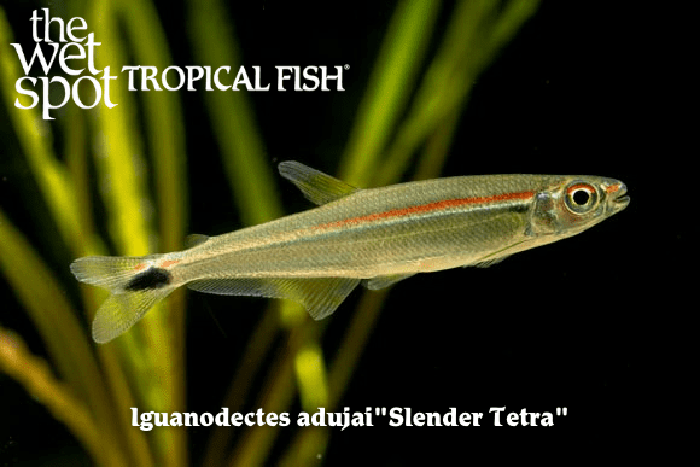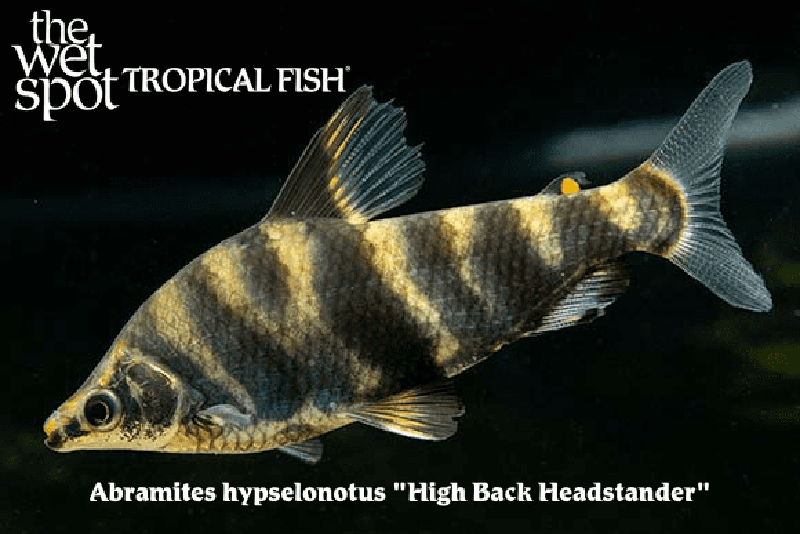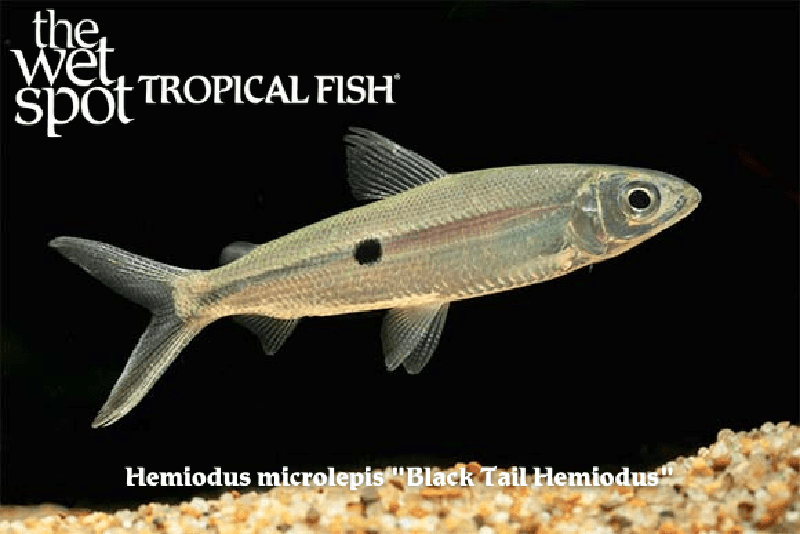Long Bodies, Long Ranges
Among mammals and many other taxonomic groups, body size is positively correlated with the species’ geographic range. Think elephants on their long journeys seeking water, bears hunting over vast lands, or whales migrating from Hawaii to Alaska. The same can be said for at least some groups of fish and has been demonstrated in Catostomids and Centrarchids where larger bodies confer larger home ranges (Pyron, 1999). From our armchairs, we can speculate the same could be true among some South American Characins, and within this very small sample, these elongate Characins all inhabit wide ranges throughout the vast river basins and networks of tributaries of South America.
Widespread throughout the Rio Negro and Orinoco basins in Brazil and northern Peru, Iguanodectes adujai is a blackwater species inhabiting smaller tributary channels. Reaching a maximum length of about 3 inches, these “Slender Tetras” are long and skinny with red eyes that lead into a long red stripe down their sides, yellow pigmentation on their undersides, and a dark caudal blotch. Typically found among dense vegetation and tree roots, they are best kept in planted setups that simulate blackwaters with soft substrate, leaf litter, driftwood, and plants rooted in the substrate, attached to hardscape, and floating. This species is a bit combative, and males will develop a bit of a pecking order with a dominant male showing the brightest coloration. They should be kept in groups of at least 8 to prevent overt intraspecific aggression. Otherwise, they are great options for blackwater community setups and may be housed alongside similarly-sized Characins, peaceful Catfish, and small to medium-sized and non-predatory Cichlids. Interestingly enough, their color and patterning are superficially similar to the Red Striped Tetra, Hemigrammus rubrostriatus. Opportunistic and omnivorous, they eat small invertebrates, filamentous algae, and fallen fruit in the wild and should be provided varied diets in captivity with a large live and frozen component and high-quality dried products with some green matter. Tank waters are best maintained with temperatures between 69°F and 77°F, a pH between 5.0 to 7.5, and a hardness up to 90 ppm.

Scientific Name:
Iguanodectes adjuai
Common Name:
Slender Tetra
Temperature:
69° – 77° / 5.0 to 7.5 pH
Native Location:
The Rio Negro and Orinoco basins in Brazil and Northern Peru
Preferred Diet:
Omnivore
A gorgeous acrobat, Abramites hypselonotus headstands across the Amazon and Orinoco in Bolivia, Brazil, Colombia, Ecuador, Guyana, Peru, Venezuela, and Paraguay. Known for their manner of swimming head down and tail up, these “High Backed Headstanders” reach up to 5.5 inches in length, have long pointed bodies with a pronounced dorsal hump, and black marbling over light-colored bodies. Hardy and able to thrive in a variety of habitat types stretched over such a vast range, this species isn’t terribly particular when it comes to tank setups. They do best in tanks with sand or smooth gravel substrate, driftwood or spiderwood, decent filtration, some water flow, and hardy plants with tough leaves, while soft-leaved plants may be eaten. Another omnivorous forager, they eat a variety of benthic items and should be fed live and frozen invertebrates, fruits and veggies, and high-quality sinking pellets. These robust, and slightly nippy schooling Characins do best in groups of 6 or more and may be kept alongside peaceful South American Cichlids, Characins of a similar size and temperament, and Catfish. Graceful and inquisitive, they shine in carefully curated setups with their quirky behavior. Not too particular with regards to water conditions, they may be kept in waters with temperatures of 68°F to 86°F, a pH between 5.5 and 7.5, and a hardness up to 268 ppm.
Scientific Name:
Abramites hyselonotus
Common Name:
High Back Headstander
Temperature:
68° – 86° / 5.5 to 7.5 pH
Native Location:
The Amazon and Orinoco in Bolivia, Brazil, Columbia, Ecuador, Guyana, Venezuela, and Paraguay
Preferred Diet:
Omnivore

A member of a rather interesting genus, Hemiodus microlepis is an elongate Characin from the Orinoco, Madeira, and Tocantins basins. Known as the “Black Tail Hemiodus”, they get up to 9 inches in the wild, though most captive specimens max out around 7 inches in length. With long silver bodies, forked caudal fins with black spots, a dark side spot, and red-tinted pelvic and anal fins, this fish is quite handsome. Not terribly common in the hobby, these Characins require a lot of space and pristine, flowing, and well-oxygenated waters. Otherwise, tanks should be set up with sandy substrate, an arrangement of wood pieces and water-worn rocks, floating plants, and tight-fitting and weighted lids as these guys will soar right out if given the opportunity. Active but peaceful, they may be maintained with other robust river dwellers like Catfish and other large Characins, and can even be used as schooling species alongside Cichlids like Geophagus, Heros, or Satanoperca. Feeding chiefly on green matter in the wild, they need a regular veggie infusion in their diets from both dried products and prepared foods like blanched spinach. They’ll also go crazy for live and frozen foods and should be offered them often. Tank waters must be kept scrupulously clean with regular water changes and strong filtration, with temperatures between 73°F and 81°F, a pH between 6.0 to 7.5, and a hardness up to 268 ppm.
Many scientists start out as hobbyists ruminating over trends, observations leading to hypotheses, then to experimentation and the results that shape our understanding of how the world works. Most of us will never leave our armchairs to partake in the rigors of the scientific process, but it is this fascination and curiosity that makes us uniquely human. Happy Friday aquarists!

Scientific Name:
Hemiodus microlepis
Common Name:
Black Tail Hemiodus
Temperature:
73° – 81° / 6.0 to 7.5 pH
Native Location:
The Orinoco, Madeira, and Toscantins basins
Preferred Diet:
Omnivore
